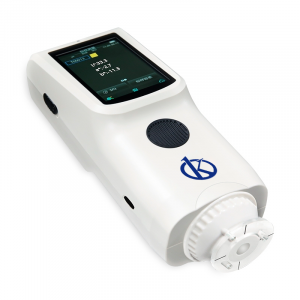A colorimeter in the laboratory is considered a very effective tool when identifying a color and its hue, since it allows to obtain a more objective measurement of it. This laboratory equipment is also an instrument that has the property of measuring the absorbance of a solution at a specific light frequency.
Colorimeters commonly have in their structure a light source and three filters. The light source emits light at a wavelength and then passes through a filter before impacting the object being measured. So a colorimeter is used to measure the amount of light that passes through a specific color, a feature that is very useful for understanding how colors work and used to create new colors.
Characteristics of a laboratory colorimeter
A laboratory colorimeter is a device used to measure the intensity of light at different wavelengths, usually having a prism, which is placed on or near an object, and a photoelectric cell that converts light into electricity. The device then measures the intensity and wavelength of any light that passes through it. In other words, this instrument has the ability to quantify the color and compare it with another, expressing the result in a numerical value assigned to the color, thus providing a fast and more accurate analysis.
A colorimeter consists of three main parts: a source light, a bucket containing the sample solution and a photocell that detects the light transmitted through the solution. To produce color light, the equipment is equipped with specific color filters or LEDs. The light transmitted by the solution in the bucket is detected by a photocell, producing a signal that can be measured on a numerical scale.
How does a colorimeter work?
The operation of a colorimeter is based on the principle that the absorbance of a substance is proportional to its concentration, that is why the more concentrated substances give a higher absorbance value. A filter is used on the colorimeter to choose the color of light that will absorb the solute the most, in order to maximize the accuracy of the reading. Equipment sensors measure the amount of light that passes through the dissolution or material, comparing the incoming amount and reading the absorbed amount.
This equipment is based on the principle of the Lambert and Beer Law, which proposes that the concentration of the absorbent material is proportional to an amount known as “absorbance”. Therefore, if you can determine the absorbance of a solution of an unknown concentration substance and compare it with the absorbance of solutions of known concentrations, you can find the concentration of the substance in the solution being tested. Thus, when light of a particular color (or wavelength range) is directed through a chemical solution, for example, the solution absorbs some light and some of it is transmitted.
What is the importance of a colorimeter in the laboratory?
A colorimeter is a device that acts by measuring the amount of light reflected by a given object. So it is a very important equipment in laboratories for research and design purposes, moreover, it can also be used for quality control systems in industrial laboratories, to ensure that products are manufactured according to the required specifications.
A laboratory colorimeter is an instrument that uses light to measure the reflectance of a material, which is why it is widely used in scientific research to measure the color of materials and detect trends. It is a valuable tool that can be used in many different ways.
What does Kalstein offer you?
Kalstein is a manufacturer of medical and laboratory equipment of the highest quality and the best technology at the best PRICES in the market, so you can make your PURCHASE confidently with us, knowing that you have the service and advice of a company specialized in the field and committed to provide you with safe, economical and effective options to perform your functions in the right way. That is why we present our: Precision Colorimeter YR053439.
This device has high precision and low cost and two apertures, and a tip opening of Φ4 mm, suitable for the use of most samples. Among its main characteristics are: HERE
- Built-in white plate parameters. You do not need to calibrate each time you take a quick measurement.
- Double openings: flat opening of Φ8 mm and tip opening of Φ4 mm for switch, easy to measure concave sample in a large plane.
- Equipped with a built-in high capacity rechargeable lithium-ion battery. It is not necessary to buy the battery repeatedly.
- Handheld design: small and convenient; easy measurement.
- Exquisite appearance: adopts traditional and fashionable aesthetic designs.
- High cost performance: great production, good quality, cheap products
For more information we invite you to take a look: HERE

